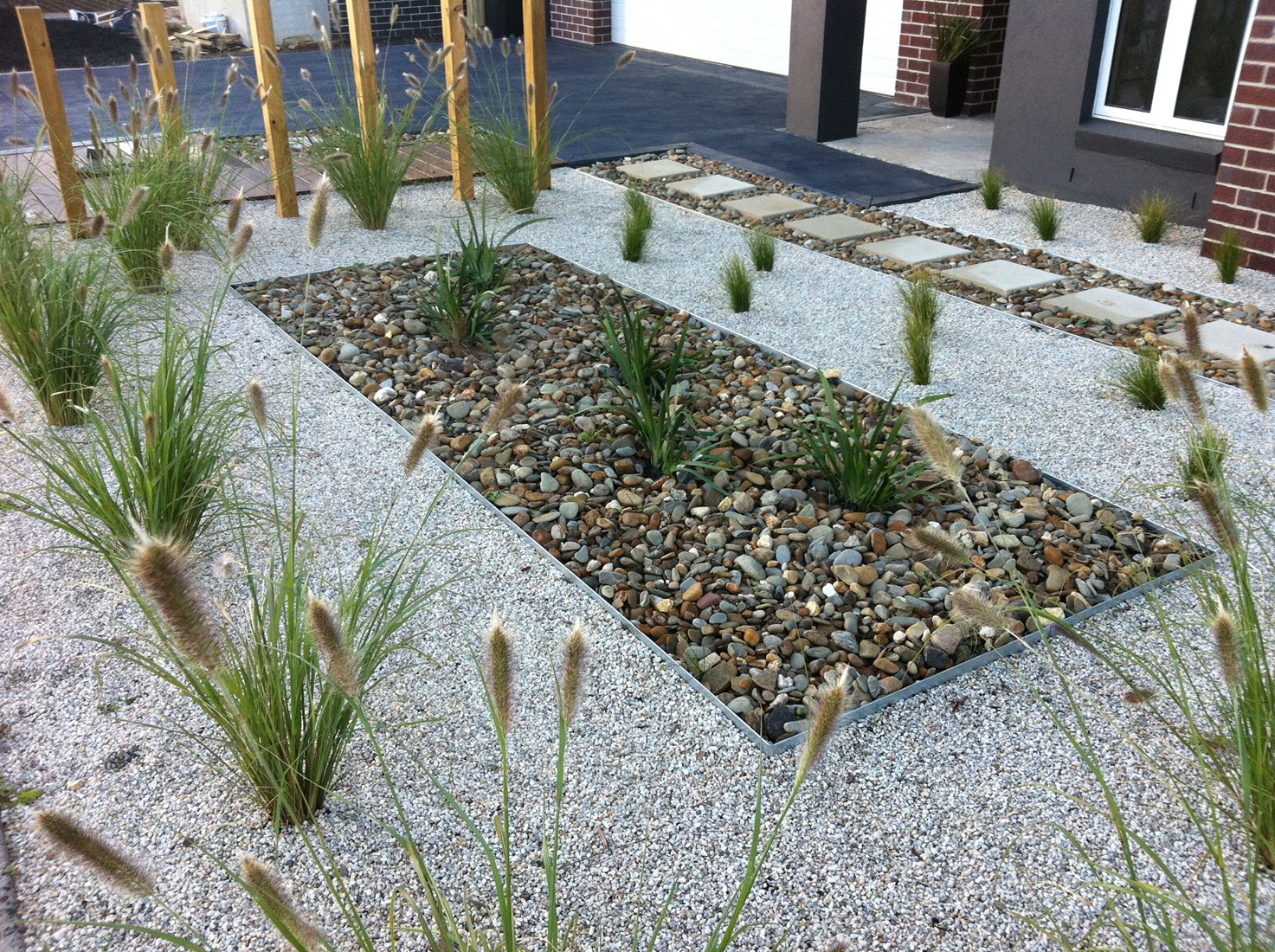A well-kept lawn beautifies your outdoor space and reflects your dedication to garden maintenance. This is especially true in the bustling urban landscape of Sydney, where compact gardens are a standard feature. In these snug spaces, every inch counts, making efficient use of the area crucial.
Lawn edging can be a game changer in such scenarios. It’s a functional tool to delineate distinct areas of your garden and an aesthetic element that adds finesse to the overall landscape. This comprehensive article explores the varied world of lawn edging, examining a range of materials apt for compact gardens in Sydney and spotlighting the increasingly popular Corten steel edging.
Understanding Lawn Edging in Compact Spaces
Effective space management is crucial in small garden spaces to maximise beauty and utility. Lawn edging is pivotal in this context, offering much more than just a visual appeal. It acts as a critical boundary marker, clearly defining the separate areas of your garden. This demarcation is significant in compact gardens, where every inch counts and distinct zones for various activities or plant types are necessary.
The primary function of lawn edging is to maintain order and neatness. It keeps the grass in its designated area, preventing it from invading flower beds, vegetable patches, or walkways. This containment is not just about maintaining a tidy appearance; it also helps in the easier maintenance of the garden. For instance, when grass doesn’t creep into flower beds, it reduces the need for frequent trimming and weeding, saving time and effort for the gardener.
Moreover, lawn edging contributes to the lawn’s and adjacent plantings’ health. Defining clear boundaries ensures that grassroots don’t compete with other plants for nutrients and water. This separation can be particularly beneficial in a small garden with limited resources.
Several factors must be considered when selecting the suitable material for lawn edging. The material should not only complement the aesthetic of your garden but also be durable and functional. Options range from natural materials like stone or wood, which can blend seamlessly with the garden environment, to more modern alternatives like metal or plastic, which offer longevity and minimal maintenance. The choice of material can also influence the garden’s overall style – for instance, sleek metal edging might suit a contemporary garden. At the same time, classic brick or stone can enhance a traditional garden’s charm.
In addition to material choice, the design of the edging plays a role. Some gardeners prefer a more pronounced edge that stands out as a design feature, while others opt for something subtler, almost hidden, to let the plants themselves be the focus. The height and depth of the edging are also important considerations, impacting both its effectiveness in containing grass and its visual impact.
In summary, lawn edging in small gardens is a practical tool for space management and an opportunity to enhance the garden’s aesthetic. By carefully selecting the right material and design, gardeners can create a functional, beautiful, and well-defined space that makes the most of their limited area.
Popular Lawn Edging Materials for Small Gardens
Creating a beautiful and functional small garden involves carefully considering every element, including the choice of lawn edging materials. Lawn edging defines the garden’s layout and impacts its aesthetic and maintenance requirements. Here, we explore some of the most popular lawn edging materials suitable for small gardens, each offering unique benefits and styles.
Natural Stone
Natural stone edging is a perennial favourite in garden design, prized for its durability and organic aesthetic. This material excels withstanding weather conditions, ensuring long-lasting, well-defined garden borders. The natural hues and textures of stone add a layer of sophistication and rustic charm, suitable for various garden styles, from traditional to modern. Its robust nature requires minimal maintenance, which is ideal for gardeners who enjoy their garden’s beauty with little upkeep.
In addition to its visual appeal, natural stone is an environmentally friendly choice. Often sourced locally, it reduces environmental impacts associated with transportation. Its use can enhance natural drainage and soil health, benefiting the garden’s ecosystem. The versatility in shapes and sizes allows for creative installation, from smooth, uniform lines to more natural, irregular patterns, making natural stone edging a timeless and versatile option for small gardens.
Metal Edging
Metal edging is highly regarded for its strength and sleek appearance, making it a preferred choice for gardeners who aim to create clean, defined lines in their outdoor spaces. Aluminium and steel are the most popular materials in this category, each offering unique advantages. Aluminium is particularly favoured for its lightweight and corrosion-resistant properties. It’s easy to install and shape, ideal for gardens with intricate designs. This material is also durable, maintaining its appearance with minimal upkeep.
Steel, in contrast, is known for its robustness. It’s well-suited to withstand various weather conditions, making it a versatile choice for gardens in different climates. Among the types of steel, Corten steel stands out for its distinctive characteristics.
Corten steel is specially formulated to develop a rust-like appearance over time. This rusting process forms a protective layer against further corrosion, enhancing its weather resistance. This feature is crucial for gardens in areas like Sydney, which experience varied climates. The rusted patina of Corten steel offers a unique aesthetic, blending beautifully with the natural elements of a garden.
The evolving appearance of Corten steel, which combines industrial strength with natural beauty, has made it a popular choice in contemporary garden designs. It provides not just functionality but also a striking design feature. This material adds a dynamic visual element that changes with the seasons, enhancing modern gardens’ overall look and feel.
READ: Rustic Elegance: Embracing Corten Steel for Sustainable Lawn Edging in Sydney’s Gardens
Installing Corten Steel Edging in Small Gardens
Installing Corten steel edging is a relatively simple process that can be effectively carried out even in gardens with limited space. The first step in this installation process involves planning the edging layout. Use a garden hose or spray paint to mark the desired path for the edging. This method allows for flexibility and adjustment before any permanent changes are made, ensuring that the final layout aligns perfectly with your garden design.
Once the path is marked, the next step is to prepare the ground for installation. This involves digging a trench along the marked line. The depth and width of the trench will depend on the dimensions of the Corten steel edging being used. It’s important to ensure that the trench is dug uniformly to maintain a consistent height and appearance of the edging once installed.
After the trench is prepared, place the Corten steel edging into it. Care should be taken to align the edging correctly, ensuring it follows the planned path and sits evenly in the trench. This step might require some adjustments as you work along the length of the trench to maintain the desired shape and direction.
The final step is to secure the edging in place. This is done by backfilling the trench with soil. As you fill the trench, compact the soil around the edging to ensure it is firmly anchored. This compaction is crucial as it provides stability to the edging, preventing it from shifting over time due to weather conditions or garden activities. Once the soil is compacted, a final check should be done to ensure the edging is straight and at the desired height.
Maintenance and Care
Corten Steel’s appeal lies in its aesthetic qualities and low-maintenance nature, making it an ideal choice for garden edging. A basic but regular cleaning routine is recommended to preserve its unique protective layer and ensure longevity.
The first step in maintaining Corten steel is regularly clearing away debris such as leaves, soil, and organic matter that may accumulate against the edging. This debris can trap moisture and potentially lead to accelerated corrosion, which is counterproductive to the steel’s natural rust-forming process that protects it. Simply brushing off the debris with a soft broom or hand brush can keep the area clean.
When cleaning the surface of Corten steel, gentleness is key. Use water and a mild detergent to cleanse the surface gently. This can be done using a soft cloth or a sponge, which helps remove any dirt or bird droppings that may have settled on the steel. It’s important to avoid using harsh chemicals or abrasive cleaning tools like steel wool or wire brushes, as these can scratch the surface and disrupt the protective rust layer.
In some cases, if the Corten steel has developed stains or marks that are difficult to remove with mild detergent, a specialised cleaner designed for use on metals can be employed. However, it’s crucial to follow the manufacturer’s instructions and test the cleaner on a small, inconspicuous area first to ensure it doesn’t adversely affect the steel’s appearance.
Regular cleaning maintains the aesthetic appeal of Corten steel and contributes to its durability. By following these simple maintenance steps, gardeners can enjoy the unique beauty and practical benefits of Corten steel edging for many years with minimal effort and without needing costly or time-consuming upkeep.
READ: Lawn Edging Mistakes: Common Pitfalls And How To Avoid Them
Creative Ideas for Lawn Edging in Compact Gardens
Creative lawn edging in small gardens opens personal expression and aesthetic enhancement possibilities. Mixing Corten steel and natural stone can create a visually striking and unique look. Corten Steel’s modern, industrial feel paired with the classic, natural beauty of stone offers a compelling contrast, adding texture and colour to the garden.
Experimenting with patterns and layouts is critical to achieving a custom garden design. Alternating segments of different materials, playing with their heights and widths, or incorporating curves can add rhythm and depth to the garden space. These design choices are particularly impactful in small gardens, where each element is prominent and contributes significantly to the overall appeal.
In essence, lawn edging in small gardens is about blending creativity with personal style. By thoughtfully combining various materials and designs, gardeners can transform their space into a distinctive and inviting outdoor area that reflects their tastes and maximises their garden’s visual potential.
Lawn Edging and Plant Selection
Selecting the appropriate plants is crucial in complementing your lawn edging and elevating the overall appeal of your garden. Choosing low-maintenance and space-efficient plants is critical in a city like Sydney, where garden spaces are often compact. These selections not only enhance the beauty of the lawn edging but also ensure that the garden remains manageable and aesthetically pleasing.
Succulents are an excellent choice for gardeners looking for minimal upkeep. Their diverse shapes, sizes, and colours can add a unique texture and visual interest to the garden. Being drought-tolerant, they are well-suited to Sydney’s climate and require minimal watering, making them a practical choice for busy gardeners or those seeking a low-maintenance landscape.
Herbs are another great option, particularly for those who appreciate aesthetics and functionality. Many herbs, such as rosemary, thyme, and lavender, offer culinary benefits and beautiful foliage and flowers. They can be planted along the edges to create a fragrant, edible, practical, and visually appealing border. Herbs generally require little space and can thrive in small garden beds or containers.
Dwarf shrubs and trees are ideal for adding structure and height to a compact garden without overwhelming the space. These smaller versions of popular shrubs and trees provide the same visual appeal as their larger counterparts but are more proportionate to smaller gardens. They can serve as focal points or create a sense of depth and layering in conjunction with the lawn edging.
Incorporating these plant types into your garden design complements the lawn edging and ensures that your garden remains a manageable and delightful space. By choosing low-maintenance, space-efficient plants like succulents, herbs, and dwarf shrubs and trees, you can create a harmonious and sustainable garden that thrives in Sydney’s unique environment.
Conclusion
Lawn edging is crucial in sculpting a tidy, functional garden, especially in small spaces. You can craft a unique, visually stunning garden that maximises the available space by selecting appropriate materials, such as Corten steel, and combining them with innovative design ideas. We encourage you to explore the various lawn edging options available for your small garden and create a delightful outdoor sanctuary to enjoy for many years.


